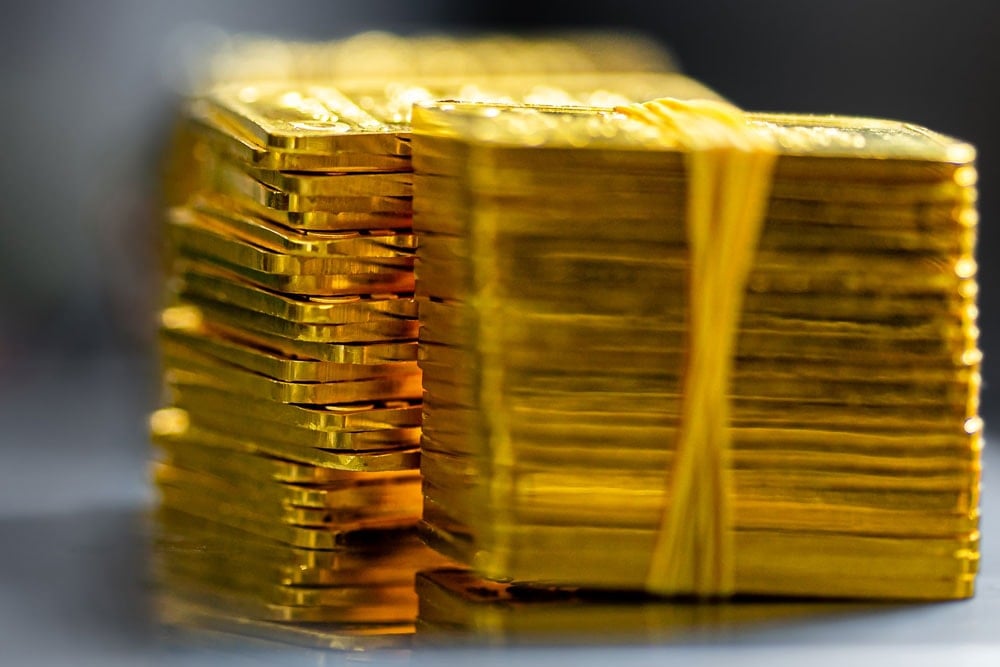
In the early morning trading session on July 9 (Vietnam time), the spot gold price on the international market plummeted, at times falling to nearly 3,290 USD/ounce (equivalent to 105.3 million VND/tael including taxes and fees), compared to 3,340 USD/ounce on the evening of July 8.
This development surprised many investors in the context of the unstable world . Global financial markets were shaken after US President Donald Trump announced tariffs of 25 to 40% on 14 countries from August 1. Two allies, Japan and South Korea, were subject to a 25% tariff.
In Ukraine, tensions continue to escalate. Ukraine has spent billions of dollars building defenses but has failed to stop the enemy. Russia continues to expand the area of land it controls.
Mr Trump is also continuing to put more pressure on the BRICS countries. Meanwhile, forums such as the G7 and G20 are in a stalemate due to internal divisions and Mr Trump's "America First" approach.
China has warned the Trump administration not to inflame trade tensions by resuming tariffs on Chinese goods in August. The US and China agreed in June to a framework deal to halt their trade war, but details have been unclear.
It can be seen that the world is in a very unstable situation. Previously, if only one of the above events happened, the price of gold would have skyrocketed and would have continued to escalate if the tension continued. However, over the past 6 weeks, the price of gold has not been able to break out, and has even tended to weaken, with many consecutive weeks of price decline, even though the decline was not too deep.
Gold prices failed to increase despite receiving a flurry of supportive information, from geopolitical tensions, policy instability, inflation risks, budget deficits in countries to unpredictable economic prospects...
Where does the money go?
So where does the money flow and is gold still an attractive investment channel?
In fact, the demand for gold is still very high. The "big players" in the market still keep buying every time the price of gold drops. They are the central banks of many countries, including China, Russia, Türkiye... and large organizations, including banks and gold ETFs.
The People's Bank of China bought 2,298 tonnes of gold for the eighth consecutive month in June. The Russian Central Bank, Türkiye and Germany also increased their gold holdings. The United States is currently the country with the largest gold reserves, with about 8,133 tonnes.
In addition, gold is also imported into other countries unofficially. Türkiye has recorded a large gold smuggling situation. The Istanbul Jewelry Chamber of Commerce (İKO) estimates that about 5,000 tons of gold are hidden in Turkish people's homes, worth at least 500 billion USD.
However, official gold imports from countries have shown signs of slowing. For example, China bought just 2 tons of gold in June, down sharply from an average of 17 tons in the first five months of the year, or more than 10 tons in December last year.
Gold prices have increased by 25-27% since the beginning of 2025 and increased very strongly in 2024. This is a factor that makes central banks of countries consider buying gold, possibly only buying when gold has sharp declines. Despite the weakening trend, gold often rebounds every time the price falls below the threshold of 3,300 USD/ounce - a level considered to be a fairly strong support level in recent times.
In addition, gold is also under pressure from profit-taking activities, especially from flexible funds. Organizations and individuals sell gold and seek profits from other assets, including US stocks. The US stock market has been rising for the past few months and is at a historical high.
A weaker dollar usually helps push gold prices higher. The DXY recently fell to 97, but is now rebounding. On the morning of July 9, the DXY was at 97.6.
Pressure from Mr Trump on BRICS and other countries may help the greenback recover even though the US faces the risk of increasing budget deficit and Mr Trump is still pressuring Fed Chairman Jerome Powell to cut interest rates.
Money also found its way into some digital currencies. Bitcoin is up 3.3% over the past 7 days and is near $109,000/BTC.
Gold is also supported by the Middle East - a region that has been hot for decades, showing signs of stability after the ceasefire agreement between Israel and Iran and could become a more sustainable development region, with an orientation towards technological cooperation with the US, not just oil and gas.
Some technical analysis based on Elliott waves and Fibonacci sequences shows that gold may be in a strong downtrend, with each peak being lower than the previous peak. The price of gold may even fall to $2,800/ounce, before turning around and increasing again before reaching a new peak in the next 1-2 years.
Domestically, in the morning trading session of July 9, the price of 9999 gold bars at SJC and Doji was listed at 118.6-120.6 million VND/tael (buy - sell), down 400,000 VND in both directions compared to the previous session. SJC gold rings from 1-5 chi also decreased by 400,000 VND/tael, Doji round gold rings decreased by 500,000 VND/tael.
HA (according to Vietnamnet)Source: https://baohaiphongplus.vn/gia-vang-the-gioi-giam-xuong-muc-tuong-duong-105-3-trieu-luong-dong-tien-chay-vao-dau-415965.html































![[Photo] Gia Lai provincial leaders offer flowers at Uncle Ho's Monument with the ethnic groups of the Central Highlands](https://vphoto.vietnam.vn/thumb/1200x675/vietnam/resource/IMAGE/2025/7/9/196438801da24b3cb6158d0501984818)






































































Comment (0)